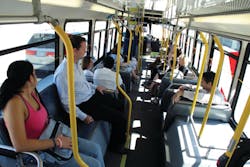March Networks launches transit-focused video surveillance offering
This week at the American Public Transportation Association Expo in Houston, Texas, March Networks debuted its new RideSafe video surveillance solution designed specifically for bus, para-transit and passenger rail applications. The RideSafe solution is essentially comprised of several different components including: March Networks Command for Transit video management software; the RideSafe GT Series Hybrid Transit NVR; and a new portfolio of IP cameras purpose-built for mobile environments such as the IR Wedge, IR MicroDome, and Forward Facing and HD WDR NanoDome.
According to Net Payne, chief marketing officer for March Networks, the company initially launched a dedicated video recording platform for buses and railcars about 10 years ago, applying the same principles it had used for fixed transit facilities – rail stations, bus and train depots, etc. – but hardened for mobile environments.
“The largest impediment of a moving product on a bus or a train is all of the shock and vibration combined with spinning drives and taking a fixed product and trying to put it in a mobile environment – most of the companies in the market were really failing at that,” explained Payne. “There had not been a really reliable product to ensure your data was there when you needed it or when you had an incident. Combine that with the fact that there was very limited centralized management, so you could have a large fleet of buses that had adopted video but you had very manual processes for getting that video off of the bus instead of using wireless, high-speed downloading capabilities.”
With the lessons March Networks has learned from continuing to develop and build reliable products for the transportation vertical through the years, Payne said the company felt the time was now right to combine all their various technologies into a streamlined solution for the market. One of the things that really differentiates RideSafe from some of the other video management and recording platforms that are geared towards the transit industry, according to Payne, is that the Command for Transit software is the same for both fixed and mobile applications.
“Today, 99 percent of transit agencies are using different video systems for their stations, waysides and depots that are completely segregated from what is on their buses and trains,” said Payne. “With Command, we’re able to manage our fixed recording platforms and our mobile recording platforms through the same software. You can manage it, push upgrades, download video, and conduct investigations across all of your companies’ locations and assets. That’s something you really don’t see on an enterprise-class scale in the transit business.”
Additionally, because the majority of transit agencies are still using analog video cameras, Payne said that the RideSafe GT Series Hybrid NVR enables customer to leverage their existing coax infrastructure while making the migration over to IP video.
“Rather than retrofit a complete vehicle, they can leave the analog cameras they have or add IP parts that they want based on the funding they have,” added Payne. “They can have that hybrid system and move themselves to all IP over time. We’ve actually created a modular design so that our customers can upgrade the NVR in the field and add IP capabilities – up to 20 cameras – with the performance that this product has. While they may not be ready to have more than four IP cameras today, they know that by buying this product they have the investment protection to increase it up to 20 IP cameras over time.”
Two other important parts of the RideSafe solution include:
- March Networks’ GURU, a free smartphone application built to save technicians time and costs in the field. By using the app to scan unique QR codes on each RideSafe GT Series recorder, technicians gain instant access to diagnostic and product warranty information, as well as express return and repair processing.
- Rapid access to live and recorded video. Incorporating high-speed wireless video extraction, the RideSafe solution allows transit operators to automatically download recorded video along with synchronized GPS data as vehicles enter maintenance yards, fueling depots or other Wi-Fi areas. This wireless capability also enables authorized staff and law enforcement to view live or recorded video from any vehicle on demand.
Payne said that March Networks has had three customers trial the RideSafe solution over the last six months and that the company's engineers have been out in the field extensively testing it to ensure it is up to their reliability standards.
“I think the market has really accepted the fact that video is a requirement for most moving vehicles, whether that is Tier 1 transit agencies with buses and light rail down to all of the movement you see towards cameras on school buses, police cars and taxis. It’s an accepted fact that video is going to be present in virtually all of these vehicles going forward,” said Payne. “What we’ve tried to do is create a very reliable product. When there’s an incident, our customers know that video is going to be there for them and that has been our trademark in the industry.”
About the Author
Joel Griffin
Editor-in-Chief, SecurityInfoWatch.com
Joel Griffin is the Editor-in-Chief of SecurityInfoWatch.com, a business-to-business news website published by Endeavor Business Media that covers all aspects of the physical security industry. Joel has covered the security industry since May 2008 when he first joined the site as assistant editor. Prior to SecurityInfoWatch, Joel worked as a staff reporter for two years at the Newton Citizen, a daily newspaper located in the suburban Atlanta city of Covington, Ga.

